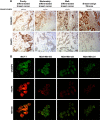4-Amino-2-trifluoromethyl-phenyl retinate inhibits proliferation, invasion, and migration of breast cancer cells by independently regulating CRABP2 and FABP5
- PMID: 29731607
- PMCID: PMC5927060
- DOI: 10.2147/DDDT.S151029
4-Amino-2-trifluoromethyl-phenyl retinate inhibits proliferation, invasion, and migration of breast cancer cells by independently regulating CRABP2 and FABP5
Retraction in
-
4-Amino-2-Trifluoromethyl-Phenyl Retinate Inhibits Proliferation, Invasion, and Migration of Breast Cancer Cells by Independently Regulating CRABP2 and FABP5 [Retraction].Drug Des Devel Ther. 2024 Jul 3;18:2713-2714. doi: 10.2147/DDDT.S484570. eCollection 2024. Drug Des Devel Ther. 2024. PMID: 38979401 Free PMC article.
Abstract
Background: 4-Amino-2-trifluoromethyl-phenyl retinate (ATPR), a novel retinoid derivative, inhibits proliferation and induces differentiation in many cancer cells. In this study, the inhibitory effects of ATPR on the proliferation, invasion, and migration of breast cancer (BC) cells, and the relationship between ATPR and the expression of the intracellular lipid-binding proteins CRABP2 and FABP5 were investigated.
Methods: CRABP2 and FABP5 expression was evaluated in infiltrating breast-infiltrating ductal carcinoma(BIDC) and benign breast fibroma (BBF) by immunohistochemistry and in MCF-7, MDA-MB-231, MDA-MB-435, and MDA-MB-453 cells by immunofluorescence. The inhibition of proliferation by ATPR in these cells was detected by MTT. After downregulation and upregulation of CRABP2 and FABP5 in MCF-7 or MDA-MB-231 cells using siRNA and plasmids, the effect of ATPR on proliferation was detected by MTT and real-time cell analysis, and the effects of ATPR on the invasion and migration of MDA-MB-231 cells were detected using a Boyden chamber assay and a wound healing assay.
Results: CRABP2 expression was moderately or strongly positive in BIDC and BBF. FABP5 expression was also moderately or strongly positive in BIDC, but weakly positive or negative in BBF. CRABP2 and FABP5 were highly expressed in MCF-7 cells, moderately expressed in MDA-MB-453 cells, and weakly expressed in MDA-MB-435 and MDA-MB-231 cells. ATPR inhibited proliferation more strongly in MCF-7 cells than in other cells. The inhibition of proliferation by ATPR depended on an increase in CRABP2, but not FABP5 expression. A decrease in FABP5 could inhibit the invasion and migration of BC cells.
Conclusion: These findings indicate that ATPR might inhibit proliferation by upregulating CRABP2, and inhibit invasion and migration by downregulating FABP5 in BC cells. These findings may facilitate the use of differentiation therapy in BC.
Keywords: ATPR; CRABP2; FABP5; breast cancer; invasion; migration; proliferation.
Conflict of interest statement
Disclosure The authors report no conflicts of interest in this work.
Figures








References
-
- Siegel RL, Miller KD, Fedewa SA, et al. Colorectal cancer statistics, 2017. CA Cancer J Clin. 2017;67(3):177–193. - PubMed
-
- Chen W, Zheng R, Baade PD, et al. Cancer statistics in China, 2015. CA Cancer J Clin. 2016;66(2):115–132. - PubMed
-
- Chen NN, Li Y, Wu ML, et al. CRABP-II- and FABP5-independent all-trans retinoic acid resistance in COLO 16 human cutaneous squamous cancer cells. Exp Dermatol. 2012;21(1):13–18. - PubMed
Publication types
MeSH terms
Substances
LinkOut - more resources
Full Text Sources
Other Literature Sources
Medical
Research Materials
Miscellaneous

